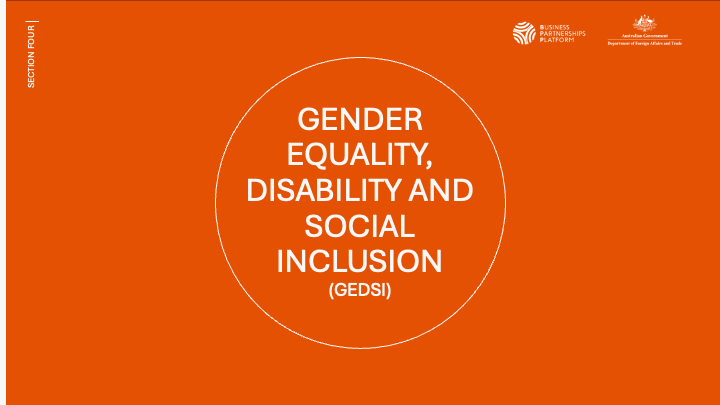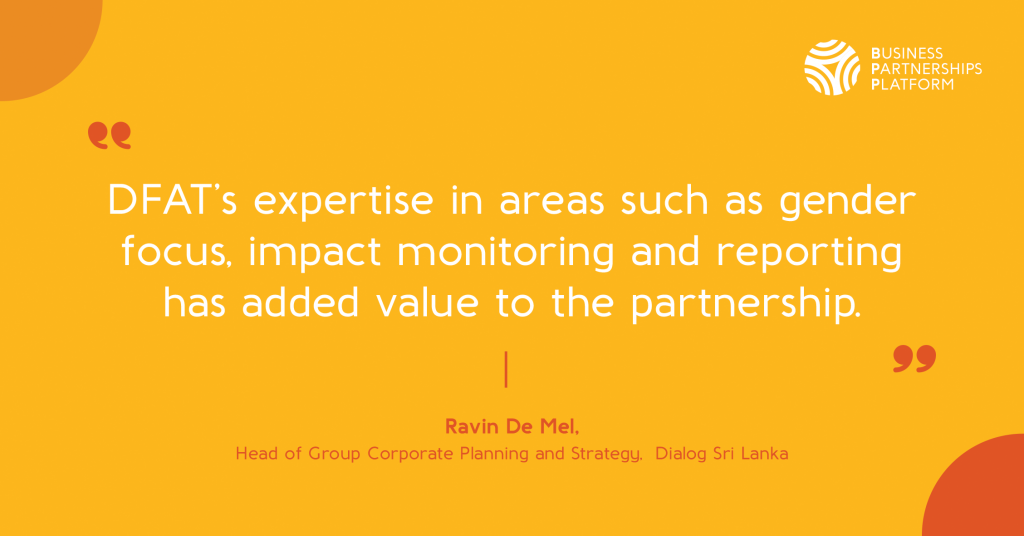Section four: Gender equality, disability and social inclusion

A guide to how businesses can promote gender equality, social inclusion and disability inclusion and how we can support you.
Our partnerships seek to bring about change by removing barriers to participation for women and that of marginalised groups. In this section we offer an explanation of what we mean by gender equality and social inclusion and the levers available to our business partners to create change. We can help determine what lever is the most appropriate for your organisation and offer support and advice to maximise impact.
Social inclusion
Inclusion is about ensuring that the right conditions are in place so that every person can achieve their full potential.
We know that economies and societies perform at their best when they include women and marginalised groups, and when their skills, expertise, and networks are valued. Economies cannot reach their full potential if they exclude large portions of the population from full participation.
Businesses can benefit from engaging a diverse workforce, profit from expanding their client base and can become more resilient when their supply chains are inclusive and do not cause harm to the communities they engage.
In many economies worldwide women and marginalised groups are prevented from participating fully in economic life due to legal or systemic barriers, education and skills gaps, a lack of access to productive resources, or cultural and social barriers. While governments have a role to play in creating policies which encourage inclusive economies, in most countries, private businesses are the largest employers and provide a wide variety of goods and services to communities. As a result, engaging the private sector as advocates for gender equality and social inclusion is a critical step on the path towards equal economic participation for these groups.
Gender equality
Businesses are recognising, and many already recognise, the value of diversity in their organisations, and are coming up with creative approaches to keep women engaged, build their skills and promote them to leadership roles.
This delivers both social and financial returns. Having a diverse workforce and ensuring women are in leadership roles enhances business performance including through better risk management, improving employee engagement and productivity, attracting talent and bringing more diverse views to solve complex problems.
Opportunities for promoting gender equality in the workforce include:
- Removing gender pay gaps;
- Introducing flexible working hours (e.g. part-time work) and support for childcare;
- Establishing women’s bathrooms and women’s work floors;
- Addressing sexual harassment and bullying;
- Providing safe transport for women to and from work;
- Providing work-based healthcare including sexual and reproductive health services;
- Providing work-based training;
- Promoting women into leadership roles;
- Recognising women’s labour; and
- Changing attitudes, mindsets and policies across the workforce to support greater diversity.
Businesses are also increasingly recognising the significant potential to develop and market products that address women’s unmet needs both in and outside the household, particularly in developing markets.
This includes time saving devices, access to finance and banking, communications, transport, nutrition, health care, child care, and agricultural work where women continue to dominate. Taking the time to understand women’s role in household decision-making can open up new opportunities. While women may not be highly visible, and decisions may be made, or appear to be made, by male relatives, women may be the end users of products and have significant influence on purchasing decisions. Understanding these dynamics can help sharpen marketing approaches, while also delivering better products and services to women end users.
In developed countries, marketing to women has gone beyond ‘shrink it and pink it’. It has evolved into an area of innovation and growth for business, tapping into women’s increasing incomes as they engage more in the paid workforce and a better understanding how women make and influence decisions.
Read our Gender Equality Checklist, designed to help you evaluate your existing practices regarding gender equality, and provide a set of practical steps that your organisation can take to make a positive impact.
Learn more about the BPP’s Mekong Delta Climate Adaptation Partnerships – Empowering Women Framework.
Disability inclusion
Disability is a spectrum of the ability of people to perform different functions.
It is experienced in diverse ways, depending on context and severity. It is not always easily identifiable and can be invisible to the extent that the disabled person may not always identify themselves as disabled. Inclusion of people with disability can be inhibited by attitudinal and/or societal barriers (such as stigma), physical and/or environmental barriers (such as stairs), and policy and/or systemic barriers, which can create a disabling effect.
Research has found that discrimination against people with disabilities cuts companies off from the productive potential, talents, contributions and the purchasing power of a significant part of the population. Traditional attitudes and discrimination, mean that people with disabilities make up only a tiny percentage of personnel in formal employment in most countries. The ILO calculates that excluding people with disabilities costs countries 3-7% of annual GDP.
There is a clear business case and return on investment for disability inclusion. Of the 1.3 billion people who are disabled, an estimated 20% are severely disabled, and 80% have less severe or mild or no difficulties. It is this large proportion of the market that can be more readily supported to participate in and benefit from private sector initiatives.
Businesses often assume that including people with disabilities within the workforce is expensive and complicated and offer limited tangible benefits. However, multiple studies have shown that disability inclusion in the workplace results in higher revenue, net income and profit margins. Workplaces that accommodate and support workers with a disability increase the available pool of talent available; increase productivity; and gain insights into broader market segments and their needs. The advantages include accessing untapped talent, enhanced productivity, loyalty and reliability and increased employee satisfaction.
Support and advice
The objectives of gender equality and social inclusion are at the heart of the BPP, which ultimately seeks to support businesses to contribute deliver social impact through commercial models.
We provide a range of guidance and support to BPP partners to help you implement successful business initiatives that also deliver economic and social benefits to women and men. This includes technical support including access to resources, expertise and support to equip you to integrate gender equality, disability inclusion and safeguards into your private sector initiatives.
In our technical support we discuss five main ways that a business can create inclusive and equitable business environments:
- Workplace practices
- Procurement practices
- Products and services
- Communications
- Safeguarding practices

Lever 1: Workplace practices
Workplaces that accommodate and support workers with disability increase the available pool of talent available; increase productivity; and gain insights into broader market segments and their needs.
Businesses can promote inclusive and equitable workplaces by recruiting more women, ensuring equal pay for equal work, having anti-discrimination and harassment policies, providing skills development opportunities for women, promoting women and people with disability into leadership positions, providing childcare services, adapting workplaces to accommodate the needs of people with a disability, and having flexible and family friendly workplace practices.
- How will your business promote an inclusive and equitable workplace?
- How many women and men will be employed?
- How many women and men will be in senior or leadership positions?
Lever 2: Procurement practices
Businesses with more inclusive supply chains often find these to be more reliable, and that their distribution networks are diversified.
Businesses can promote inclusion in their procurement practices by actively seeking out producers and suppliers that are operated, controlled or represent a significant number of minority, women, LGBTQ+, veterans, persons with a disability, or indigenous persons. They can negotiate terms of trade that provide opportunities for smaller business to grow and scale; invest in training and skills development for women and low-income suppliers to improve productivity; and help link suppliers together to benefit from economies of scale.
- How will your business promote inclusive procurement practices?
- How many women and men will be involved in your supply chain, and how?
- How many people with a disability will be involved in your supply chain, and how?
Lever 3: Products and services
The products and services of businesses have enormous potential to meet the needs of women and other customer segments that may be underserved.
This also provides an opportunity to profit from an expanded client base. Businesses are encouraged to apply universal design principles to ensure that products and services can be used by virtually everyone, including people with disabilities.
- How will your products and services be accessible to women, people with a disability and underserved customer segments?
Lever 4: Communications
The communications and marketing materials of a business can have a powerful influence on the way society views women, indigenous people, and people with a disability.
A business’ communications materials can profile women as leaders, empowered employees, and visible in supply chains and potential customers. They can promote people with disabilities as a customer segment, and tackle prejudices by profiling people with a disability as members of their workforce and the supply chain.
- How will your business communications and marketing materials challenge stereotypes, social norms and attitudes towards the role of women and marginalised groups?
Lever 5: Safeguarding practices
Businesses often interact with diverse populations in the delivery of goods and services, in their operations and supply chain activities, and through engagements with suppliers, customers, and business partners.
Businesses, therefore, have a responsibility to ensure that their work does not cause harm. This is particularly the case when businesses engage with women and marginalised groups such as people with disabilities, who may be in situations of vulnerability, or with children. More generally, businesses have a responsibility to comply with policies and laws around social and environmental protection.
Businesses that act to mitigate safeguarding risks and respond effectively to incidents can improve health and safety in their workplaces, strengthen productivity, benefit from improved access to talent and worker retention, and protect and strengthen their reputation among communities, customers and investors. These efforts can also reduce vulnerability to litigation and compensation claims, and the financial and reputational damage this can inflict on businesses and investments.
- What key strategies will your business implement to safeguard your employees, suppliers, communities, and customers?
